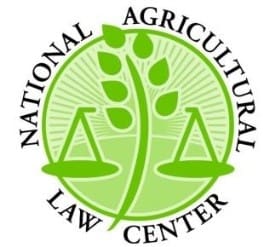A comprehensive summary of today’s judicial, legislative, and regulatory developments in agriculture and food. Email important additions HERE.
ANNOUNCEMENT: Mark your calendar for the next Agricultural & Food Law Consortium webinar, Wednesday, May 2: Water Wars in the United States Supreme Court: Why Should Agriculture Care? Details available here.
JUDICIAL: Includes pesticides, environmental law, urb & ag, and CWA rules and notices.
MONSANTO COMPANY, Plaintiff and Appellant, v. OFFICE OF ENVIRONMENTAL HEALTH HAZARD ASSESSMENT et al., Defendants and Respondents; California Citrus Mutual et al., Interveners and Appellants; Center for Food Safety et al., Interveners and Respondents, F075362, 2018 WL 1870514 (Cal. Ct. App. April 19, 2018) concerned litigation involving California’s Proposition 65 that seeks to identify chemicals “known to the state to cause cancer.” Issue for court was whether Proposition 65’s reliance on the International Agency for Research on Cancer to identify known carcinogens “violates various provisions and doctrines of the California and United States Constitutions.” Monsanto argued “it is improper for a foreign entity . . . to determine what chemicals are known to the state to cause cancer.” Considering the legislation at issue, the court determined “there is a built-in safeguard that provides adequate protection against potentially arbitrary or abusive determinations that certain chemicals are known to the state to cause cancer.” Court ultimately concluded that California “has authority to delegate legislative authority under long-settled principles consistent with republican forms of government.”
NATIVE ECOSYSTEMS COUNCIL and Alliance for the Wild Rockies, Plaintiffs-Appellants, v. Leanne MARTEN, Regional Forester of Region One of the U.S. Forest Service; et al., Defendants-Appellees, No. 16-35577, 2018 WL 1869936 (9th Cir. April 19, 2018) involved a dispute regarding defendants’ Forest Plan in the Beaverhead-Deerlodge area and defendants’ “decision to average snag density over the Project area as a whole.” Plaintiffs appealed summary judgment ruling for defendants and argued the snag standard at issue was inconsistent with the recommendations in an older study. Plaintiffs further maintained the Forest Plan at issue “is inconsistent with the National Forest Management Act (NFMA).” Court observed “NFMA does not require a particular manner of calculating snag retention,” and that “[d]efendants relied on accepted science in determining how to calculate snag density.” Affirmed.
In CED PROPERTIES, LLC, Plaintiff-Appellant-Petitioner, v. CITY OF OSHKOSH, Defendant-Respondent, No. 2016AP474, 909 N.W.2d 136 (Wis. April 3, 2018), plaintiff, a property owner, appealed defendant’s special assessment and ruling that plaintiff received “special benefits from the construction of a roundabout, after [plaintiff] had obtained summary judgment on a challenge to a previous assessment.” City took six percent of plaintiff’s property in order to construct a roundabout for public use and re-assessed the value of plaintiff’s property after concluding that the new construction created “special benefits” upon plaintiff’s property, including “a substantial increase in accessibility, which includes safer, lower cost, and shorter travel times for customers, deliveries and employees.” Issue on appeal was whether the term “special benefits” in Wisconsin’s eminent domain statute has same meaning in the state’s special assessments statute. State Supreme Court reasoned that “[t]here is no textual basis for assigning different interpretations of ‘special benefits’ accruing to property in the context of eminent domain versus ‘special benefits’ conferred on property upon which a special assessment is levied.” Affirmed in part.
CLEAN WATER ACTION, et al., Plaintiffs, v. E. Scott PRUITT, Administrator, U.S. Environmental Protection Agency, et al., Defendants, No. 17–0817 (DLF), 2018 WL 1865919 (D.D.C. April 18, 2018) involved EPA’s actions regarding “effluent limitations” under the Clean Water Act (CWA). The EPA promulgated the Steam Electric Power Plant Effluent Limitations Guidelines Rule (ELG Rule) and later, issued an Indefinite Stay of the ELG Rule per the Administrative Procedure Act (APA), which permits an agency to “postpone the effective date of action taken by it, pending judicial review.” Plaintiffs then sued, alleging the Indefinite Stay violated the APA. Court observed that the APA “generally provides for district court review of EPA actions . . . [b]ut the Clean Water Act enumerates seven categories of EPA actions for which review lies directly and exclusively in the federal courts of appeals.” Dismissed for lack of jurisdiction.
REGULATORY: Includes AMS, APHIS, EPA, FWS, and NOAA rules and notices.
AGRICULTURAL MARKETING SERVICE: Notice AMS intends to reestablish the Fruit and Vegetable Industry Advisory Committee. Details here.
ANIMAL AND PLANT HEALTH INSPECTION SERVICE: Notice APHIS is advising the public of a preliminary concurrence with the World Organization for Animal Health’s (OIE) bovine spongiform encephalopathy (BSE) risk designations for four regions. Info here.
ENVIRONMENTAL PROTECTION AGENCY:
Rule EPA is hereby approving an application from the state of North Dakota under the Safe Drinking Water Act to implement an underground injection control program for Class VI injection wells located within the state, except within Indian lands. Info here.
Rule EPA is approving revisions to the Missouri state plan for designated facilities and pollutants developed under sections 111(d) and 129 of the Clean Air Act that were requested by Missouri Department of Natural Resources in two separate submissions made on August 8, 2011 and on July 3, 2014. Info here.
Rule EPA is extending the comment period for 30 days and is providing notice that EPA has added a supplemental analysis, titled “Supplemental Analysis of Alternative Small Business Size Standard Definitions and their Effect on TSCA User Fee Collection”, to the rulemaking docket for the proposed rule that published in the Federal Register on February 26, 2018. Details here.
FISH AND WILDLIFE SERVICE:
Notice FWS received requests from the County of Santa Cruz and City of Scotts Valley for renewal of two incidental take permits under the Endangered Species Act. Details here.
Notice FWS received an application for an incidental take permit under the Endangered Species Act. Orange County Public Schools is requesting a 3-year ITP for take of the federally listed sand skink. Details here.
NATIONAL OCEANIC AND ATMOSPHERIC ADMINISTRATION: Rule NMFS issued a final rule on December 9, 2016 to establish the Seafood Traceability Program, also known as the Seafood Import Monitoring Program or SIMP. Info here.
